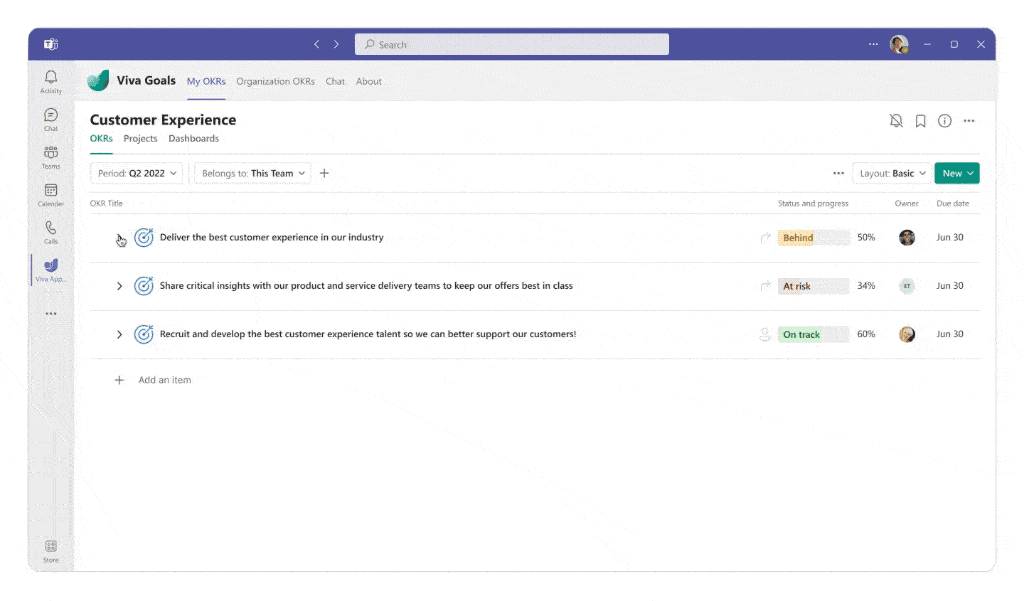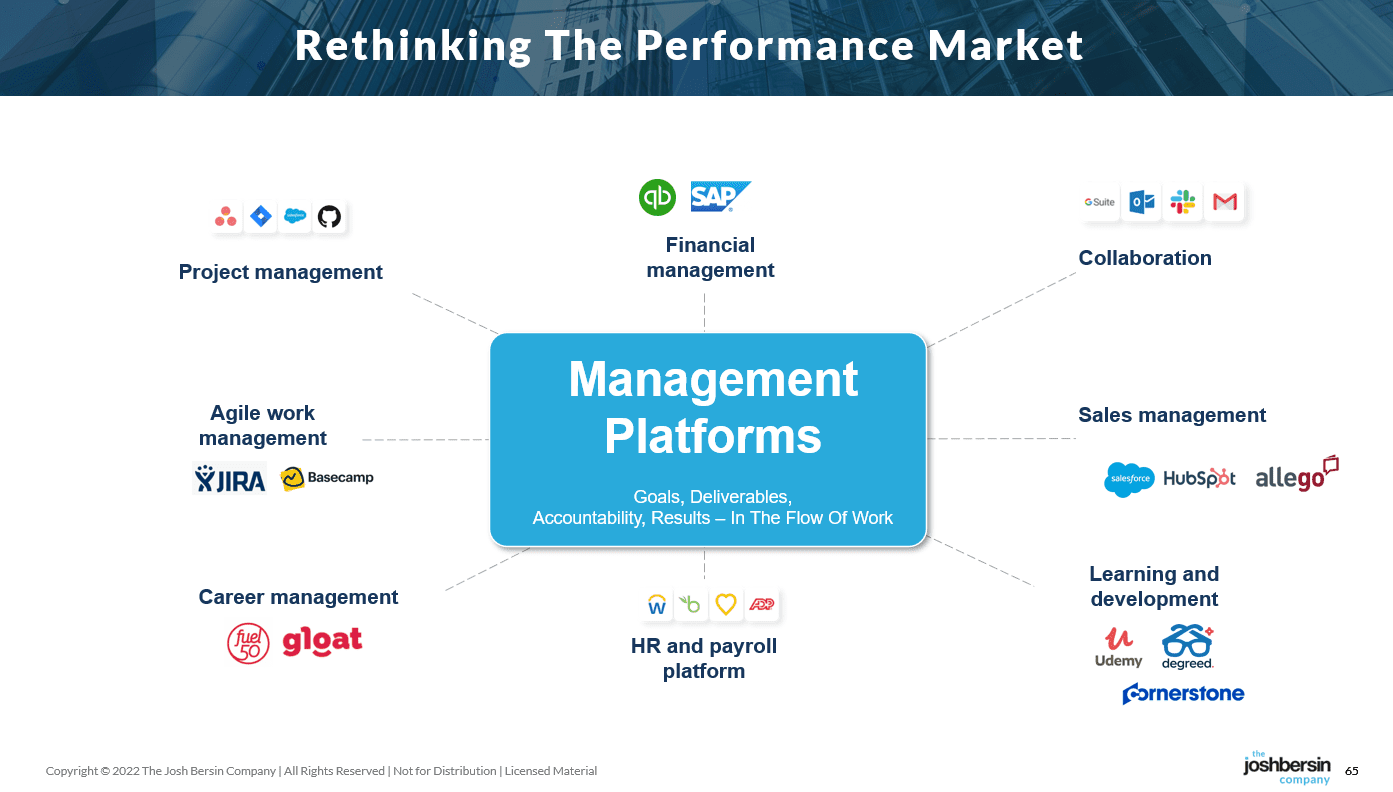Microsoft Releases Viva Goals: Performance Management Is Sexy Again
One of the most frustrating, tired, and archaic HR practices is performance management. Most of us have had horror stories with our “performance appraisals,” leading HR leaders to try to reinvent performance management all the time.
We went from top-down cascading goals in the early 2000s to Continuous Performance Management in 2010 to new discussions about Performance Enablement and what I now like to call “Performance Management in the Flow of Work.”
Well, this week Microsoft introduced Viva Goals, a snazzy OKR-based system based on Ally.io (acquired by Microsoft last Fall). And while Viva Goals is still new, it reckons the big trend going on in this space.
 |
Let me start with some of my own thoughts here. Having discussed this topic for two decades, the big issue we face is that Performance Management is not HR stuff. It’s all about managing people, work, and projects. In other words, no matter what outcome HR teams want (forced distribution, pay equity, deep succession plans, development plans), the process comes down to this: is it helping people get work done? Or is it just getting in the way?
And that very simple idea is often lost on software vendors and consultants. I’ve witnessed this personally. When I was running Bersin & Associates years ago we grew the company by 30-40% year after year with no performance management at all. People talked with each other about “what’s the priority” and “how can I get help” and the process worked fine. We had close to 75 employees when we were acquired and I never saw any reason to create goals, OKRs, cascading goals, or anything fancy.
When we were acquired by Deloitte, however, much of that changed. We put together budgets, monthly business reviews, board meetings, and executive oversight. And this was done with the best of intentions: Deloitte wanted to make sure the business was performing well through the acquisition.
Well while all that sounded good, it slowed us down. People spent time in meetings, meetings to prepare for meetings, and executive reviews. Each meeting took away time to talk about research, clients, and operations. So our growth rate started to slow, and ultimately performance began to suffer.
I left that experience with a reminder that “great businesses operate from the bottom up.”
In other words, it’s the engineers, product managers, salespeople, retail workers, truck drivers, and branch operations people who make things happen. Yes, they need budgets, they need to be aligned, and they need to know who’s responsible for what. But with experience and maturity they can set their own goals and do their best to delight their customers. We do NOT want performance management to get in the way.
Enter the new world of OKRs, one of the hottest fads in management (OKR stands for Objectives and Key Results). Intel and Google pioneered this idea, and the concept has swept across many businesses. OKRs, a modern name for “smart goals”, teach us to clearly define our objectives, measure the steps to get there, and regularly discuss what’s going on. All easy to understand.
New software tools like Viva Goals, Betterworks, 15Five, Lattice, and Workboard are designed to make this easy.
Ideally, as software vendors tell you, these tools will create goal alignment, transparency, accountability, and personal and professional growth. Sounds good, doesn’t it?
Well let me give you a dose of reality. If you’re spending more than twenty minutes a week “updating your goals”, it may be time you’re not spending on your job. It better be worthwhile. And new research from Betterworks points this out.
The Betterworks research uncovers something profound. No matter how fancy you make the process, the main thing that matters is the quality of the conversations you’re having with others. And that means peers, managers, and subordinates. The whole idea of “frequent check-ins” is over-hyped. Sometimes you want to check in daily, sometimes weekly, and sometimes not at all. We want a process where an employee can talk with their manager or peers whenever they need help, and leaders are always there to help.
And this gets into the topic of “performance management in the flow of work.” If I have to log into an ERP system, fill out a bunch of goals, and make sure they’re all quantified in order to get credit for my work, well… I’m going to get a headache. I want to do my work! Not track it so everyone else can see it.
Even the Microsoft announcement points this out: 69 percent of employees said it’s important or very important to be rewarded for the impact they deliver.
This is why salespeople hate updating Salesforce for their managers all the time. They are too busy selling! So new tools like Viva Goals, Betterworks, and others integrate with Hubspot and Salesforce to let employees embed their work right into these platforms, letting “performance management” happen in the background.
The Path Of Performance Management Tools: Into The Flow Of Work
For many years vendors like SuccessFactors built performance management systems as top-down goal alignment platforms. These tools, many of which have been acquired, were what I call a “heavy lift” for everyone. HR teams had to implement them; managers had to force people to use them; and employees had to spend time learning them.
Today, thanks to Viva Goals, Betterworks, Humu, and others, these are operational performance systems, also used for year-end reviews.
They are not just designed for goals: they have become a platform for conversations, projects, and targets that keeps track of goals, achievements, and performance gaps. And they are deeply integrated into Microsoft Teams, Slack, Google Workspace, and other important applications.
 |
This means they’re very easy to use. Platforms like Viva Goals and Betterworks let employees view, monitor, and update goals right in their email or collaboration systems. No need to fill out forms and update some ERP system to get credit for what you’re doing. Google, for example, is updating its decade-old performance process to enable conversations in the flow of work, embedded right in Google Workspace.
Colgate just implemented Betterworks in the flow of work and loves the system primarily because of its integration with Google. Viva Goals is going to do the same for Microsoft customers.
The Pandemic Helped Us Find This New Model
Companies really learned this during the pandemic. PepsiCo, in its effort to improve productivity, dramatically simplified its PM process during the pandemic and people were thrilled. They asked several thousand people to crowdsource the #1 thing getting their way at work and the most despised process to “shred” was performance management. Why? It wastes enormous amounts of time.
One consumer goods company told me they looked at email calendar data to figure out where people were spending their time for a year. They discovered that their nine-level performance management and calibration process was wasting a million hours a year! Almost the entire month of December was spent on talent reviews and calibration meetings. They cut it by 75% in only a few months of redesign.
So this old, often hated, but important process is ready for change.
And let me remind you that this is a design project, not a software implementation. You get to decide how these tools will be used.
Performance management is not “mandated by law.” Yes, if you want to fire someone you have to have a series of documented conversations. But nobody mandates that every employee have a rating, that the scale should be a certain number, or that you should do it at some regular cadence. You get to decide how this works.
What we want out of performance management is a fair and equitable measure of performance – with two big outcomes.
First, people want to know how they’re doing and how they can improve. Second, organizations want to find high performers and fairly distribute pay and rewards.
If you pay someone more because you “like them” or “they’re doing good work” everyone else will wonder “why didn’t I get that bonus?” Performance management should make this process defined, equitable, and transparent.
As far as “enabling performance,” that’s all about management. If you are a micro-manager and want to know everything your team is doing, and for some reason that’s necessary (ie. the Amazon operations center), then do as much “checking in” as you can. But make sure it’s really necessary, and it’s not just some management “visibility” or political process you no longer need.
If you work for an accounting firm, I’d guess there will be a lot of checks and reviews. But if you’re in a creative or consulting business, maybe not so much. I doubt, for example, that Johnny Ive at Apple filled out OKRs every week. Apple’s most successful products are often “late” or “lagging” – but the company is more than willing to wait to get them right. You get to make the decision on these tradeoffs.
In the case of Microsoft, Betterworks, and other vendors, I applaud them for making this stuff easier. Many of the original products in this space were “theoretically great” but “practically difficult.” They tried to automate and catalog goals when people are too busy and their work is creative, and hard to plan. Even salespeople, who are among the most metrics-oriented professionals in the world, don’t like sitting in Quarterly Business Review meetings all the time. So if these tools are easy and transparent to use, they can transform the way performance management happens.
So let me leave you with that. Microsoft’s move is big, and it’s a testament to the company’s deep understanding of the real issues in Employee Experience.
Whether you use Microsoft, Betterworks, 15Five, or some other tool, make sure the process is helping people. If your process (and tools) don’t help people get things done, you aren’t managing performance, you’re slowing it down. Congrats to Microsoft for making this possible for everyone.
PS: Does this mean Microsoft will get into more HR software? Very likely. The company’s new move to bring Glint into Viva is just the beginning.
Additional Resources
We Wasted Ten Years Talking About Performance Ratings. The Seven Things We’ve Learned.
Performance Management In The Pandemic: Becoming Your Best-Self


